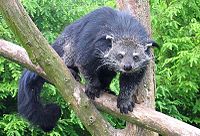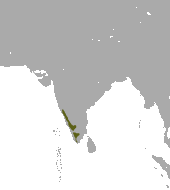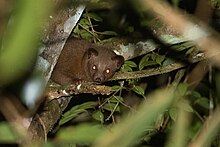பாராடாக்சூரினே
| பாராடாக்சூரினே | |
|---|---|

| |
| உயிரியல் வகைப்பாடு | |
| திணை: | விலங்கு
|
| பிரிவு: | முதுகுநாணி
|
| வகுப்பு: | பாலூட்டி
|
| வரிசை: | |
| குடும்பம்: | விவேரிடே
|
| பேரினம் | |
|
பார்க்கவும் உயிரியல் வகைப்பாடு | |
பாராடாக்சூரினே (Paradoxurinae) என்பது விவிரிடே குடும்பத்தினைச் சார்ந்த ஓர் துணைக்குடும்பம் ஆகும். இதனை முதன் முதலாக ஜான் எட்வர்டு கிரே 1864-ல் விவரித்தார்.[1] இந்தத் துணைக்குடும்பத்தின் கீழ் ஆசியப் பேரினங்கள் பாராடாக்சூரசு, பாகுமா மற்றும் ஆர்க்டிக்டுசு போக்காக்கினால் இணைக்கப்பட்டது.[2][3]
வகைப்பாடு[தொகு]
வாழும் சிற்றினங்கள்[தொகு]
| பேரினம் | சிற்றினங்கள் | விநியோகம் மற்றும் செம்பட்டியல் நிலை |
|---|---|---|
| பாராடாக்சூரசு குவெயர், 1822 | ஆசிய மரநாய் | தீவாய்ப்புக் கவலை குறைந்த இனம்
|
| பொன்னிற மரநாய் | அழிவாய்ப்பு இனம்
| |
| பழுப்பு பனை புனுகுப்பூனை
(பா. ஜெர்டோனி) பிளான்போர்டு, 1885 [4] |
தீவாய்ப்புக் கவலை குறைந்த இனம்
| |
| ஆர்க்டிடிசு தெமினிக், 1824 | பிந்துரோங்
(ஆ. பிந்துரோங்) (இரபீல்சு, 1822)[5] |
அழிவாய்ப்பு இனம்
|
| பகுமா கிரே, 1831 | முகமூடி பாம் சிவெட் | தீவாய்ப்புக் கவலை குறைந்த இனம்
|
| ஆர்க்டோகாலிடியா மெரியம், 1897[6] | சின்னப்பல் மரநாய்
(ஆ. திரிவிர்கட்டா)(கிரே, 1832) [7] |
தீவாய்ப்புக் கவலை குறைந்த இனம்
|
இன உறமுறை படம்[தொகு]
பாராடாக்சூரினேவின் இனவரலாறு கிளை வரைபடம் கீழே கொடுக்கப்பட்டுள்ளது.[8][9]
| |||||||||||||||||||||||||||||||||||||||||||
அழிந்துபோன சிற்றினங்கள்[தொகு]
- கிச்செச்சியா சாவேஜ், 1965 [10] [11]
- தக்ஜெனிக்டிசு மோராலெசு & பிக்போர்டு, 2005 [12] [13]
- கானுயிட்சு தெக்கானி தெக்கானி & வெர்ட்லின், 2008 [14] [13]
- சியாமிக்டிசு க்ரோஹே குரோகெ மற்றும் பலர், 2020 [15]
மேற்கோள்கள்[தொகு]
- ↑ Gray, J. E. (1864). "A revision of the genera and species of viverrine animals (Viverridae), founded on the collection in the British Museum". Proceedings of the Zoological Society of London for the Year 1864: 502–579. https://archive.org/stream/proceedingsofgen64zool#page/526/mode/2up.
- ↑ Pocock, R. I. (1933). The rarer genera of oriental Viverridae. Proceedings of the Zoological Society of London '1933'(4): 969–1035.
- ↑ Pocock, R. I. (1939). The fauna of British India, including Ceylon and Burma. Mammalia. – Volume 1. Taylor and Francis, London. Pp. 376–439.
- ↑ Blanford, W.T. (1855). "Exhibition and description of a skull of an apparently new Species of Paradoxurus (Paradoxurus jerdoni)". Proceedings of the Zoological Society of London: 612–613. https://archive.org/stream/proceedingsofgen85zool#page/611/mode/1up.
- ↑ Raffles, T. S. (1822). "XVII. Descriptive Catalogue of a Zoological Collection, made on account of the Honourable East India Company, in the Island of Sumatra and its Vicinity, under the Direction of Sir Thomas Stamford Raffles, Lieutenant-Governor of Fort Marlborough', with additional Notices illustrative of the Natural History of those Countries". The Transactions of the Linnean Society of London XIII: 239–274. https://archive.org/stream/mobot31753002433594#page/253/mode/2up.
- ↑ Merriam, C. H. (1897). "The generic names Ictis, Arctogale, and Arctogalidia". Science 5 (112): 302. doi:10.1126/science.5.112.302. பப்மெட்:17741859. https://zenodo.org/record/1715829.
- ↑ Gray, J. E. (1832). "On the family of Viverridae and its generic sub-divisions, with an enumeration of the species of several new ones". Proceedings of the Committee of Science and Correspondence of the Zoological Society of London 2: 63–68. https://books.google.com/books?id=ZOdJAAAAcAAJ&pg=PA68.
- ↑ Gaubert, P.; Cordeiro-Estrela, P. (2006). "Phylogenetic systematics and tempo of evolution of the Viverrinae (Mammalia, Carnivora, Viverridae) within feliformians: implications for faunal exchanges between Asia and Africa". Molecular Phylogenetics and Evolution 41 (2): 266–278. doi:10.1016/j.ympev.2006.05.034. பப்மெட்:16837215. http://uahost.uantwerpen.be/funmorph/raoul/fylsyst/gaubert2006.pdf. பார்த்த நாள்: 2019-07-01.

- ↑ Nyakatura, K.; Bininda-Emonds, O. R. P. (2012). "Updating the evolutionary history of Carnivora (Mammalia): a new species-level supertree complete with divergence time estimates". BMC Biology 10: 12. doi:10.1186/1741-7007-10-12. பப்மெட்:22369503.
- ↑ Savage, R. J. G. (1965). "Fossil mammals of Africa: 19, The Miocene Carnivora of East Africa". Bulletin of the British Museum (Natural History) 10 (8): 239–316. https://archive.org/details/bulletinofbritis10brit/page/296/mode/2up.
- ↑ Adrian, B.; Werdelin, L.; Grossman, A. (2018). "New Miocene Carnivora (Mammalia) from Moruorot and Kalodirr, Kenya". Palaeontologia Electronica 21 (1 10A): 1–19. doi:10.26879/778. http://www.diva-portal.org/smash/get/diva2:1193864/FULLTEXT01.pdf.
- ↑ Morales, J.; Pickford, M. (2005). "Carnivores from the Middle Miocene Ngorora Formation (13-12 Ma), Kenya". Estudios Geológicos 61 (3–6): 271–284. doi:10.3989/egeol.05613-668. https://digital.csic.es/bitstream/10261/2322/1/ngorora.pdf.
- ↑ 13.0 13.1 Werdelin, L. (2019). "Middle Miocene Carnivora and Hyaenodonta from Fort Ternan, western Kenya". Geodiversitas 41 (6): 267. doi:10.5252/geodiversitas2019v41a6. http://sciencepress.mnhn.fr/sites/default/files/articles/hd/g2019v41a6-pdfa.pdf.
- ↑ Dehghani, R.; Werdelin, L. (2008). "A new small carnivoran from the Middle Miocene of Fort Ternan, Kenya". Neues Jahrbuch für Geologie und Paläontologie - Abhandlungen 248 (2): 233–244. doi:10.1127/0077-7749/2008/0248-0233.
- ↑ Grohé, C.; Bonis, L. D.; Chaimanee, Y.; Chavasseau, O.; Rugbumrung, M.; Yamee, C.; Suraprasit, K.; Gibert, C. et al. (2020). "The Late Middle Miocene Mae Moh Basin of Northern Thailand: The Richest Neogene Assemblage of Carnivora from Southeast Asia and a Paleobiogeographic Analysis of Miocene Asian Carnivorans". American Museum Novitates 2020 (3952): 1–57. doi:10.1206/3952.1. https://bioone.org/journals/American-Museum-Novitates/volume-2020/issue-3952/3952.1/The-Late-Middle-Miocene-Mae-Moh-Basin-of-Northern-Thailand/10.1206/3952.1.full.






